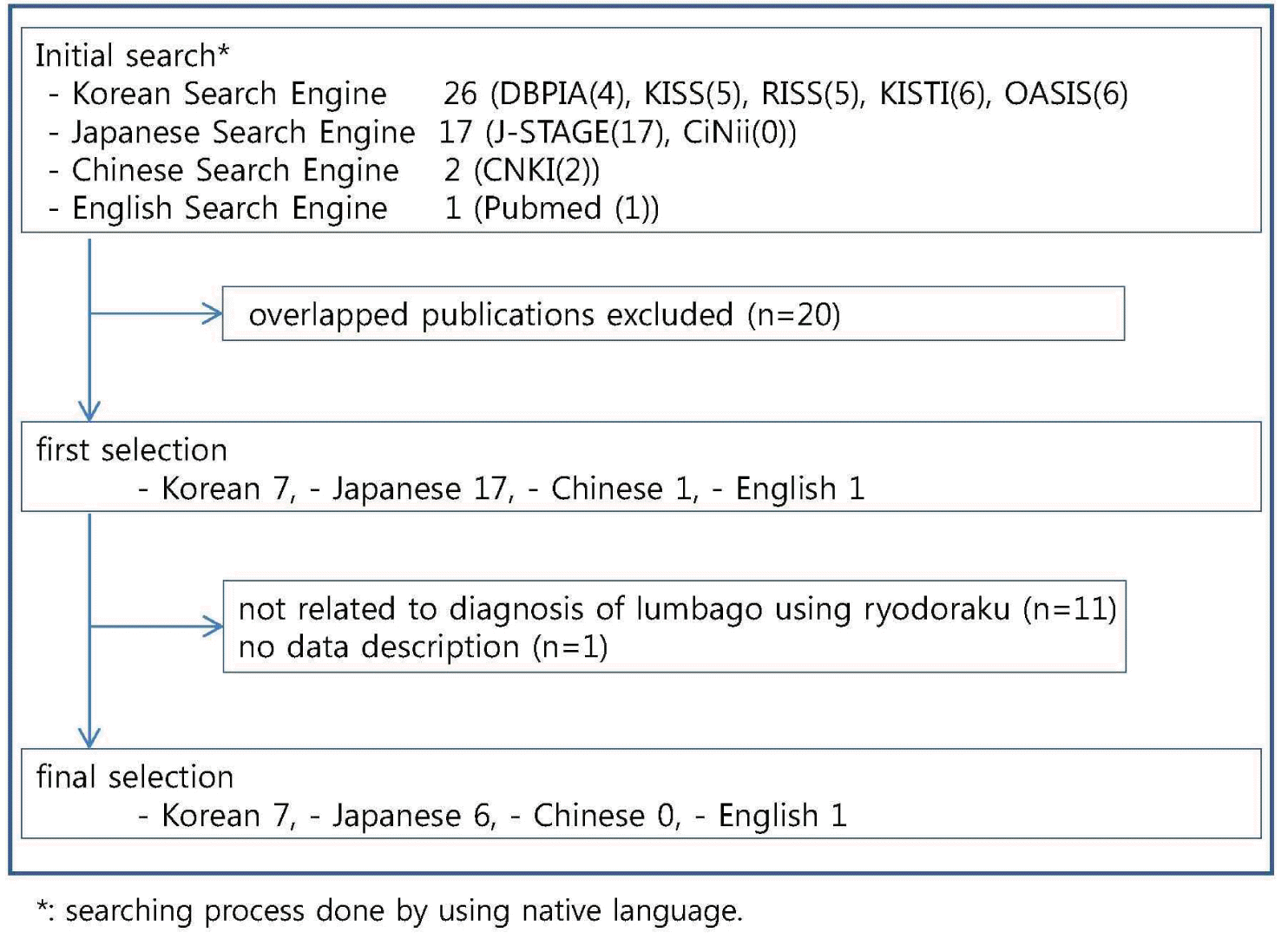References
1. Goto K. East-West Medicine of Ryodoraku Seoul: Koonja Publishing Company; 2009. p. 18–23.
2. Masayoshi H. Introduction for Ryodoraku treatment. The Japanese Journal of Ryodoraku Medicine 1989;34(6):127–37.
3. Heo J. Donguibogam Seoul: Namsandang; 1987. 278
4. The Korean Association of Pain Medicine. Exercise Guideline for Low Back Pain Seoul: Hansol Medical Publishing Company; 2011. p. 12–3.
5. Health Insurance Review & Assessment Service. Health Insurance Cost of Medical Care Expenses 2014;536
6. Kim KJ. Study on Clinical Establish Direction for Oriental Medicine Diagnosis Methods. The Journal of Oriental Physiology & Pathology 2006;20(1):245–56.
7. Hakuda E, Imai M. Statistical Observation of Ryodoraku Treatment of Low Back Pain. The Japanese Journal of Ryodoraku Medicine 2002;47(5):145–49.
8. Goto K. The Level of Average Ryodoraku Value. The Japanese Journal of Ryodoraku Medicine 2007;52(32):81–5.
9. Umemoto Y. Clinical Consideration of Low Back Pain from Ryodoraku Measurement. The Japanese Journal of Acupuncture & Ryodoraku Medicine 1978;7(5):18–23.
10. Kim MB, Kim SS, Lee JS. The Different of Yangdorak Diagnosis between Low Back Pain Patients and Medical Checkup Group in Korean Males. J Oriental Rehab Med 2010;20(1):109–17.
11. Kim KS, Chung SH, Kim SS, Lee JS. The Study on Characteristics of Ryodoraku Score in the Chronic Low Back Pain Patients. J Oriental Rehab Med 2009;19(1):145–54.
12. Takenouchi М, Tokita S. Observation of the Total Result of Ryodoraku Measurement about Lumbago. The Japanese Journal of Ryodoraku Medicine 2004. 50(1)1–7.
13. Lee JH, Kim MS, Lee EY. The Clinical Study on Yangdorak Change with Lumbargo Patients. The Journal of Korean Acupucture & Moxibustion Society 2003;20(1):74–84.
14. Oh HJ, Song HS. The Study on the Characteristics of Ryodoraku Score accoding to Sasang Constitution in the Low Back Pain Patients. The Journal of Korean Acupuncture & Moxibustion Society 2011;28(5):121–6.
15. Oh MJ, Song HS. The Correlation of Four Constitution and Ryodoraku. The Journal of Korean Acupuncture & Moxibustion Society 2011;28(5):127–33.
16. Oh MJ, Song HS. Effect of Acupuncture Treatment on Ryodoraku Score of the Patients with Chronic Low Back Pain Due to the Kidney Deficiency. The Journal of Korean Acupuncture & Moxibustion Society 2012;29(3):115–20.
17. Oh MJ, Song HS. Effect of Sa-Am Acupuncture Bladder Reinforcing Method to Ryodoraku on the Patients with Chronic Low Back Pain. The Journal of Korean Acupuncture & Moxibustion Society 2012;29(2):37–42.
18. Lin ML, Wu HC, Hsieh YH, Su CT, Shih YS, Lin CW, et al. Evaluation of the Effect of Laser Acupuncture and Cupping with Ryodoraku and Visual Analog Scale on Low Back Pain. Evidence-Based Complementary and Alternative Medicine 2012Article ID 521612. 7.
19. Yamanaka M. Ryodoraku Diagonosis and Treatment of Lumbago from Abnormal Abdominal Conditions. The Japanese Journal of Acupuncture & Ryodoraku Medicine 1973;3(3):20–1.
20. Morikawa K, Kibi N, Kitamura S. Ryodoraku Treatment of Lumbago. Journal of the Japan Society of Acupuncture and Moxibustion 1986;36(2):102–12.
21. Kumasaka T. Low Back Pain in TCM Seoul: Cheonghong; 2013. p. 13–33.
22. Rene C. Low Back Pain Syndrome 5 edth ed. Seoul: Yeongmun Publishing Company; 2001. p. 145–217.
23. Shin SW. Low Back Pain: Review of Anatomy and Pathophysiology. J Korean Med Assoc 2006;49(8):656–7.
24. Park JR. Disgnosis and Management of Chronic Low Back Pain in Elders. J Korean Geriatr Soc 2001;Jun. 5(02):101–115.
25. Nakatani Y. Skin Electric Resistance and Ryodoraku. J. Autonomic Nerve 1956;6:52.
26. Yun CY, Lee NG, Kim SH. Inner Canon of Huangdi Daejeon: Joomin Publishing Company; 2003. p. 307–8.
27. Heo J. Sinpyeondaeyeok Donguibogam Seoul: Bubin Publishers Company; 2005. p. 1318.
28. Yang YS, Kamano T. TCM Treatment of Lumbago, Neuralgia and Arthralgia. Kugil Media 2000;:61–84.

